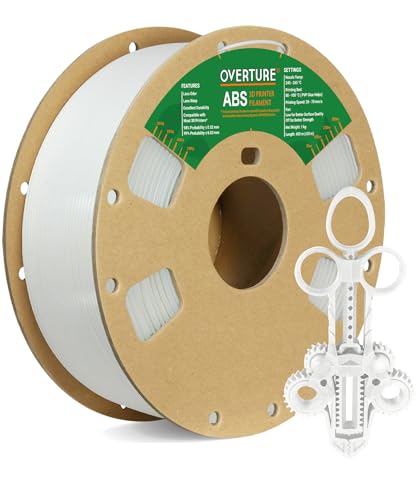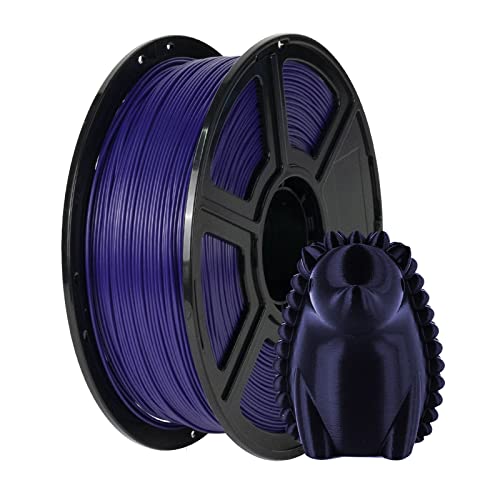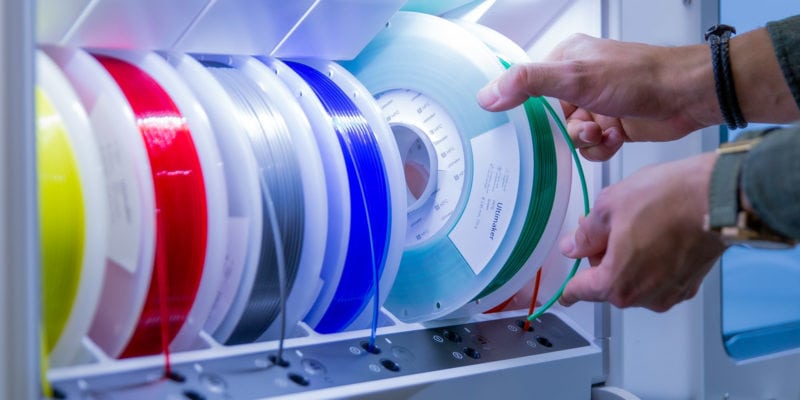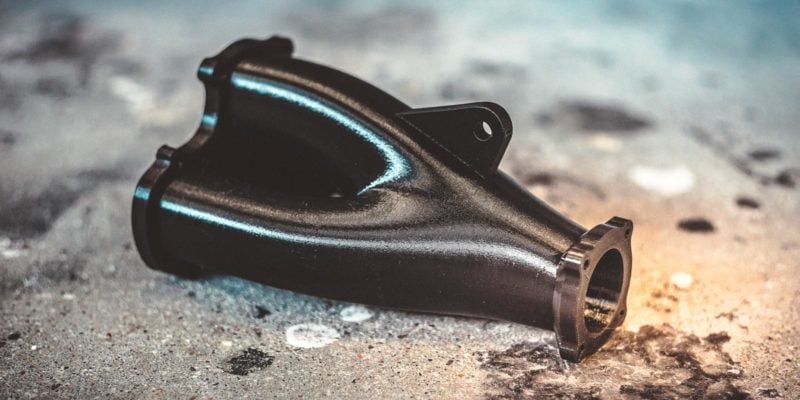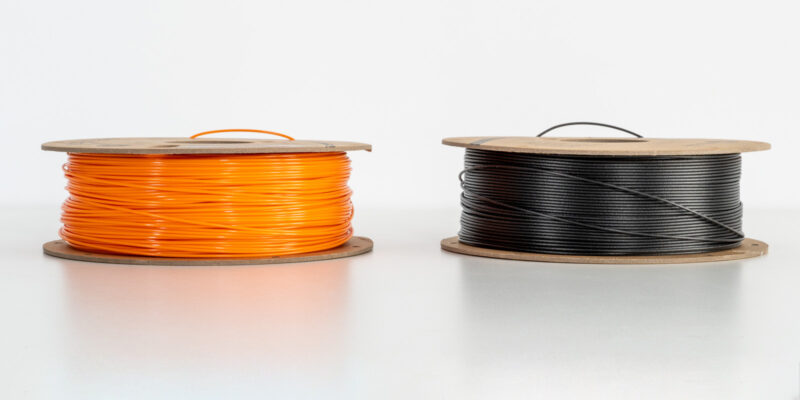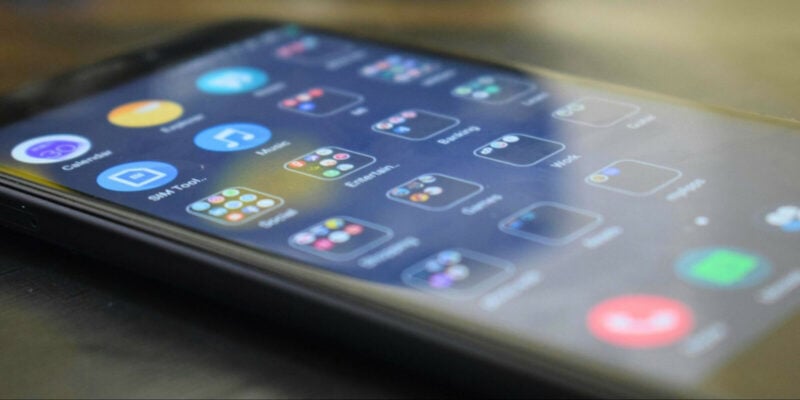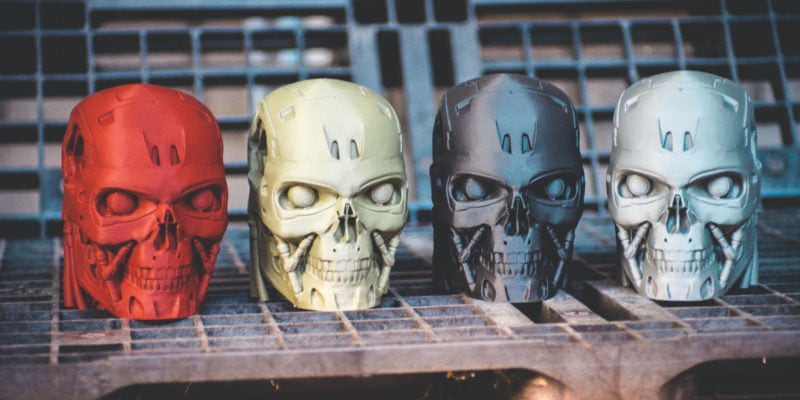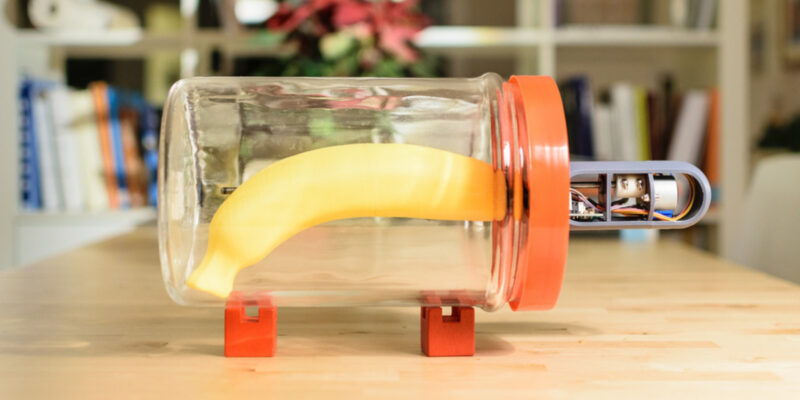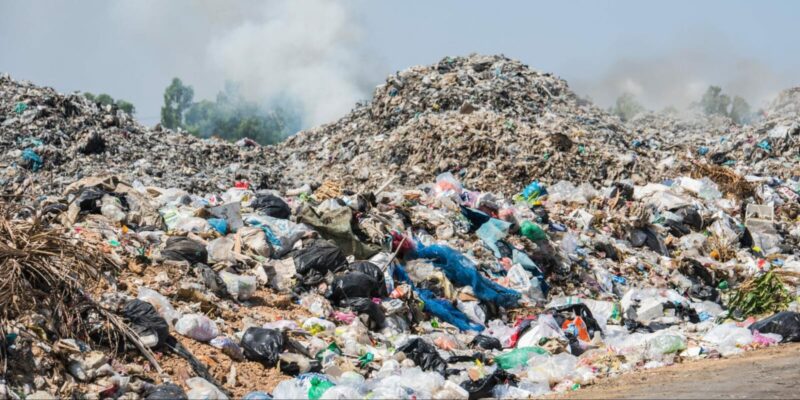ABS (acrylonitrile butadiene styrene) is one of the most common 3D printing materials thanks to its easy post-processing and high heat resistance. Since it’s such a popular material, there are countless options to choose from when buying a spool for your 3D printer.
In this article, we’ll dive into the best ABS filament brands, what to look for when buying ABS filament, how to 3D print with ABS, and when you should use it.
| Best ABS Filament | Colors | Spool size(s) | Diameter(s) | Price/kg | Best Offer |
|---|---|---|---|---|---|
| Polymaker PolyLite ABS | 10 | 1kg | 1.75mm, 2.85mm | $23 | |
| FormFutura ABS | 10 | 250g, 1kg, 2.3kg, 4.5kg, 8kg | 1.75mm, 2.85mm | $27 | |
| Hatchbox ABS | 21 | 1kg | 1.75mm, 3mm | $22 | |
| Overture ABS | 5 | 1kg | 1.75mm | $20 | |
| Sunlu ABS | 5 | 1kg | 1.75mm | $22 | |
| Flashforge ABS Pro | 19 | 1kg | 1.75mm | $22 | |
| MatterHackers Build Series ABS | 20 | 1kg | 1.75mm, 2.85mm | $21 | |
| eSun ABS | 22 | 1kg, 3kg | 1.75mm, 2.85mm | $23 | |
| Ultimaker ABS | 10 | 750g | 2.85mm | $50 | |
| Amazon Basics ABS | 4 | 1kg | 1.75mm | $20 |
Why Use a Quality ABS Filament?
ABS filament has useful properties, like high temperature resistance, but it is one of the more difficult materials to 3D print with. It is prone to problems with warping, shrinking and first layer adhesion.
A high-quality 3D printer filament manufacturer can address some of the issues that make ABS difficult and unpleasant to use by adding additional polymers and binders to their products.
In addition to special formulas, the best ABS filament brands also take greater care during the manufacturing process and make their products from premium-grade material. This provides not only a better printing experience but also a safer one since you have a better idea of what is in your products.
The Best ABS Filament Brands in 2024
PolyMaker’s PolyLite ABS filament is a premium filament option designed for better and safer printability than the average ABS filaments. It produces less odor and harmful fumes during the printing process, making it the ideal option for anyone who needs to print ABS in their living areas.
It also has great color consistency and matching. All of its filament colors are based on Pantones (a color matching system widely used in the print and design industries) with matching RGB values and hex codes. Not only does this ensure a rigorous standard for matching shades from one batch to another during manufacturing, but also ensures that users know exactly what shade to expect.
This filament also has excellent layer adhesion and bed adhesion, two of the most common issues with ABS. It is also very dimensionally stable, meaning it won’t warp or shrink during the printing process like some lower-quality filaments. Overall, it results in high-quality prints that require less post-processing, which can save you both time and money.
Technical Details |
|
|---|---|
| Product Name | PolyMaker PolyLite ABS |
| Printing Temperature Range | Nozzle: 245°C - 265°C Bed: 90°C - 100°C |
| Diameter(s) | 1.75mm, 2.85mm |
| Spool Size(s) | 1kg |
| Colors Available | Black, White, Grey, Blue, Red, Green, Yellow, Orange, Teal, Purple |
If you want an option for every possible application, FormFutura’s ABS filaments likely have you covered. They offer seven different lines of ABS filaments, each with a different function and mechanical properties.
Their TitanX ABS filaments are a special formula that has 65% more impact resistance than regular ABS material, produces minimal fumes and odors, and has excellent bed adhesion. Available in 7 colors and up to 8kg spools, you have a lot of flexibility for possible projects. And if you are looking for a more environmentally friendly option, their reForm filaments are made from recycled bits of their TitanX filaments.
Their Premium ABS line is their most basic 3D printer filament. Even so, it is still designed for better printability than standard ABS resin. The EasyFil line expands on the Premium ABS formula for better impact and heat resistance. Their other three lines ABSpro, ABSpro Flame Retardant, and ClearScent ABS all focus on decreased flammability and improved chemical resistance.
Technical Details |
|
|---|---|
| Printing Temperature Range | Nozzle: 245°C - 270°C Bed: 90°C - 110°C |
| Diameter(s) | 1.75mm, 2.85mm |
| Spool Size(s) | 250g, 1kg, 2.3kg, 4.5kg, 8kg |
| Colors Available | Atomic Green, Dutch Orange, Flaming Red, Frosty White, Natural, Ocean Blue, Robotic Grey, Solar Yellow, Strong Black, Sweet Purple |
For a multipurpose ABS 3D printer filament, Hatchbox ABS is an excellent choice. Available in over 20 colors (including specialty colors like glow in the dark and glitter) and with good quality, you can easily make this your go-to brand for pretty much any project.
Hatchbox’s recommended nozzle temperature range for their ABS filament is rather low at 210°C – 240°C. This means it’s the perfect option for 3D printers without an all-metal hot end since the PTFE tubing in non-all-metal hot ends starts to melt after 240°C. If you don’t have the best hot end and aren’t ready to upgrade your parts just yet, Hatchbox ABS will likely still work with your stock 3D printer.
Hatchbox also has a high level of accuracy with a dimensional accuracy of +/-0.03mm. This is extremely important for fit and function, as well as for 3D printing moving parts. If the filament isn’t accurate, your moving parts may not fit together properly or may not move as smoothly as they should.
With so many color and quality options available, Hatchbox ABS is one of the best budget ABS filament brands for any 3D printing project.
Technical Details |
|
|---|---|
| Printing Temperature Range | Nozzle: 210°C - 240°C Heated Bed Recommended |
| Diameter(s) | 1.75mm |
| Spool Size(s) | 1kg |
| Colors Available | Brown, Copper, Glow in the Dark, Gold, Green, Light Blue, Mint Green, Orange, Pastel Green, Pink, Purple, Red, Silver, Transparent Green, Transparent Red, Transparent White, Transparent Yellow, White, Yellow |
Affordable and formulated for greater ease of use, Overture ABS is one of the best ABS filaments for beginner ABS users. It is designed to have fewer odors and warping during 3D printing without compromising any of the strength and durability expected of ABS.
The 3D printer filament has decent dimensional accuracy, with it measuring at +/-0.05mm using advanced CCD diameter measuring. Coupled with their 24-hour drying period for all spools, Overture ABS filament provides a smooth 3D printing experience free of bubbling, clogging, tangling, or jamming.
Overture’s website also offers discounts when you buy in bulk, so if you go through a lot of filament on the regular, this could be an economical option for you.
Technical Details |
|
|---|---|
| Printing Temperature Range | Nozzle: 245°C - 265°C Bed: 80°C - 100°C |
| Diameter(s) | 1.75mm |
| Spool Size(s) | 1kg |
| Colors Available | White, Black Red, Grey, Blue |
If you need an ABS filament that doesn’t run quite so hard on your 3D printer, try Sunlu’s ABS products. While they are a bit lacking in color options, they have one of the lowest temperature ranges of any of the other filaments on this list. With a recommended range of 230°C – 240°C for the nozzle temp, Sunlu ABS is one of the best ABS filament options for a 3D printer without an all-metal hot end.
Their +/-0.02mm dimensional accuracy means their spools are manufactured with a low margin for error. Their filaments are also dried for 24 hours before packaging, meaning the spools come out of the bag ready to print and with no worries about possible bubbling or jamming.
If you’re looking for a filament that is easy to use and doesn’t require a lot of post-printing work, Sunlu ABS is a great option.
Technical Details |
|
|---|---|
| Printing Temperature Range | Nozzle: 230°C - 240°C Bed: 85°C |
| Diameter(s) | 1.75mm |
| Spool Size(s) | 1kg |
| Colors Available | Black, Blue, Grey, Red, White |
Perhaps best known for their enclosed 3D printers, Flashforge’s ABS Pro filament is nothing to scoff at either. Formulated to improve some of the less desirable features of ABS filament, Flashforge Pro is odorless and smokeless while 3D printing. It also has a slightly higher tensile strength and flexibility rating than standard ABS, making it a great option for parts that need additional strength.
It’s another low extruder temperature option, so if you have difficulty keeping your ABS prints up to temp, this filament is worth a try. It works beautifully in Flashforge 3D printers and is preprogrammed into their proprietary slicing software Flashprint to produce the best results possible, so it is your best ABS filament option if you also use a Flashforge machine.
They have an excellent variety of colors to choose from, and their end prints have a glossy and smooth finish to them. Since the Pro formula reduces shrinkage, final prints will also have a greater dimensional accuracy to the original model than you would have with other ABS filaments.
Technical Details |
|
|---|---|
| Printing Temperature Range | Nozzle: 220°C - 240°C Bed: 80°C - 100°C |
| Diameter(s) | 1.75mm |
| Spool Size(s) | 1kg |
| Colors Available | Black, Blue, Bronze, Coffee, Copper, Galaxy Black, Galaxy Blue, Gold, Green, Grey, Orange, Purple, Rainbow, Red, Silver, Skin, Transparent, White, Yellow |
When you need a cheap bulk option without compromising on quality, MatterHackers ABS filaments typically do the trick. They have a huge selection of colors available and bulk discounts when you buy multiple rolls.
Their ABS filaments are a basic offering made with standard ABS material. It offers the same heat resistance, easy post processing, and flexibility of traditional ABS. While many of the other ABS 3D printer filament brands on this list have low warping properties thanks to added polymers, Build Series works very much like you would expect from ABS (warping included).
Technical Details |
|
|---|---|
| Printing Temperature Range | Nozzle: 230°C - 240°C Bed: 90°C - 100°C |
| Diameter(s) | 1.75mm, 2.85mm |
| Spool Size(s) | 1kg |
| Colors Available | White, Black, Magenta, Pink, Red, Orange, Yellow, Lime Green, Forest Green, Green, Light Blue, Blue, Purple, Brown, Tan, Glow in the Dark, Grey, Natural, Silver, Gold |
eSun offers three different types of ABS filaments. Their basic ABS 3D printer filament is made from standard ABS resin and has good toughness, scratch resistance, and heat tolerance. Their ABS+ line is designed for smoother flow and printability, while their ABS Max products take this a step farther by decreasing warping and cracking and improving overall durability.
Like other ABS 3D printer filament brands, eSun ABS filament can be post-process smoothed with acetone vapor. In addition to having over 20 color options available, eSun ABS filament takes added color well. If you prefer to paint your whole model (for example on 3D printed cosplay armor) or just add the details, you’ll get great adhesion with this product.
You can buy them in 1kg or 3kg spools. This is a good option if you print a lot of large prints since you don’t have to change out the spool mid-print for big projects with the 3kg roll.
Technical Details |
|
|---|---|
| Printing Temperature Range | Nozzle: 220°C - 260°C Heated Bed Recommended |
| Diameter(s) | 1.75mm, 2.85mm |
| Spool Size(s) | 1kg, 3kg |
| Colors Available | Clear, Natural, Black, Light Blue, Green, Grey, Orange, Pink, Red, Silver, Blue, Peak Green, Cold White, Warm White, Yellow, Gold, Purple, Magenta, Pine Green, Beige, Brown, Dark Red |

Made for the Ultimaker 3D printers, Ultimaker ABS is a high-quality 3D printer filament with great layer adhesion and strikingly detailed 3D printing capabilities. Finished prints come out glossy and beautiful, some looking more like an injection molded part than a 3D printed one.
While they are designed to work specifically with the Ultimaker, you can use them in any 3D printer that has a 2.85mm extruder setup. They don’t make these filaments in any other size, so if you have a printer with a 1.75mm extruder (which is the most common), you’ll need to look for another ABS filament.
Ultimaker ABS filaments can withstand temperatures of up to 85°C before they begin to soften. This is slightly lower than most other ABS 3D printer filament brands that usually withstand around 100°C, but it’s not so low that it can’t handle most of the common ABS applications.
Technical Details |
|
|---|---|
| Printing Temperature Range | Nozzle: 225°C - 260°C Heated Bed Recommended |
| Diameter(s) | 2.85mm |
| Spool Size(s) | 750g |
| Colors Available | Pearl Gold, Red, White, Black, Blue, Green, Silver, Yellow, Grey, Orange |
Amazon Basics ABS is one of the more average ABS filaments for makers on a small budget. Produced to reduce printer jamming and vacuum packaged to reduce moisture absorption, it takes away some of the problems experienced with cheap no-name ABS filament.
They don’t list their dimensional accuracy or much about their manufacturing process. While the quality is generally good, the user reviews indicate that quality control from batch to batch can be an issue.
Amazon Basics ABS is worth including on this list due to its adequate quality and wide availability, but not one we recommend over the other options on this list.
Technical Details |
|
|---|---|
| Printing Temperature Range | Nozzle: 235°C - 255°C Bed: 100°C - 110°C |
| Diameter(s) | 1.75mm |
| Spool Size(s) | 1kg |
| Colors Available | Blue, Red, Dark Grey, Black |
ABS vs ASA
ASA filament (Acrylonitrile Styrene Acrylate) is a newer material to the 3D printing industry that is now being used as a substitute for ABS 3D printer filament. ASA is a thermoplastic similar to ABS that is gaining popularity with 3D printing enthusiasts for its chemical and UV resistance over ABS.
ASA also shrinks less and has great layer adhesion and flexibility. Its heat resistance, tensile strength, and durability are similar to ABS, but where ASA really shines is with the UV and moisture resistance that makes it perfect for parts that need to be outside in the elements. Even more exciting, ASA can be acetone smoothed just like ABS.
Some 3D printer filament manufacturer brands like Prusament and ColorFabb have already stopped producing ABS 3D printer filament and have replaced it with ASA. Whether or not other brands will start to follow suit remains to be seen.
ASA is almost always an improvement over ABS, even though it has a higher cost and has less color options at the moment. For those reasons, many users continue to use ABS.
Buying the Best ABS Filament: What to Pay Attention to
Consistent Filament Diameter
Having a consistent filament diameter is critical to ensure good print quality and to reduce mechanical issues with your 3D printer. An ABS 3D printing filament with an inconsistent diameter can cause extrusion issues, clogging, and even jamming.
When looking for the best ABS filament, look for its dimensional accuracy. It’s a number that tells you exactly how much a filament’s diameter will fluctuate within the roll. The standard dimensional accuracy range for the filament diameter is +/-0.05mm.
That means the finished filament will be up to 0.05mm smaller or larger than the advertised size. The smaller the number, the more precise the manufacturing process, the fewer problems you will run into, and the more accurate your 3D prints.
Packaging
While ABS filament is not as sensitive to water as PETG or PLA filament, it is still important to ensure that it is not affected by moisture before use. The best ABS filament will come packaged against water absorption. Filament rolls should be in vacuum-sealed bags and include a packet of desiccant.
While you can remove moisture with a filament dry box or even a food dehydrator, it is best to start with a dry filament from the outset.
Material Purity
A good-quality ABS 3D printer filament uses premium materials to ensure quality. Cheap filament brands often contain additives and contaminants like heavy metals and other toxic materials. It is extremely difficult (if not impossible) to tell exactly what is in these products. That is why it’s important to find a brand you trust that is transparent about its additives.
Color Consistency
Another issue to consider when choosing your next ABS filament is color consistency. ABS takes pigments well (unlike PETG), so color saturation between batches isn’t as inconsistent as other filament materials. Even so, it’s important to find a brand that matches their shades from one roll to the next.
If you print a large model and have to change your 3D printer filament partway through the print, there will be a noticeable line where the first spool stopped and the second spool started if their colors aren’t consistent.
This is especially important if you plan to make money with your 3D printer and sell your 3D prints. If a customer bought a planter from you and decided to get a second one later to sit next to it, they would expect the shades to match their first product.
Polymaker PolyLite is one of the best ABS filament options for color consistency thanks to its use of pantone shades.
Tips for 3D Printing ABS
As we mentioned above, 3D printing ABS filament is more difficult than other materials like PLA or PETG. Using the right print settings and knowing which factors to pay attention to goes a long way to ensure good quality prints. We’ve covered the basics below, but if you want a more in-depth resource, be sure to check out our guide to 3D printing with ABS.
Enclosure
ABS 3D printer filament needs a consistently high temperature to print to avoid warping, which can be difficult to maintain throughout the 3D printing process (especially for larger prints). An enclosed printing area can help with this by trapping the heat from the hot end and bed into the area and by preventing drafts.
An enclosure also helps keep in 3D printing fumes. ABS fumes are dangerous and shouldn’t be breathed in regularly. If you are printing in your living space, an enclosure makes it easier to vent the fumes outside. You can buy an enclosed 3D printer from the outset, or add a third-party or DIY 3D printer enclosure yourself.
Brims and Rafts
Brims and rafts are settings that can help reduce warping and curling from the build plate. A raft lays a few layers of material on the build plate and prints the model on top of it. Rafts help keep the model from warping off the build plate since it covers a larger surface area and is easier to stick to the bed.
Brims add extra material to the outside edges of the model for a few layers. They are helpful when a 3D model has areas where very little material touches the build plate. Models like figurines where just the feet touch the print bed are a great example of when to use a brim. Both brims and rafts can be removed from the 3D print once it’s finished.
Since bed adhesion and warping are common issues with ABS 3D printer filament, we recommend always starting with a brim or raft and removing it later.
Bed Adhesion
One of the biggest issues with 3D printing ABS filament is bed adhesion. Because ABS has high-temperature resistance, it has a slightly higher melt temperature than other filaments.
Along with its high shrink rate, ABS prints will start to shrink as they cool. If that happens during the print process the first layers can start to come off the build plate. As such, maintaining a consistent temperature during 3D printing is the first thing to consider for keeping your prints stuck to the bed.
ABS filament prints best on a piece of glass over a heated bed. Adding a thin layer of adhesive to the glass is usually the best way to keep your 3D prints sticking. ABS slurry (a mixture of dissolved ABS in acetone) is the most effective adhesive for ABS 3D printer filament, but even a simple glue stick will work.
Correct Cooling
Since ABS 3D printer filament needs such high temps to print, it’s not usually necessary to use the cooling fan on it. Using the cooling fan in its typical settings usually results in warping and poor layer adhesion.
If you want to use the cooling fan, we recommend turning it on towards the end of the print when most of the plastic has already been laid down.
Filament Storage
ABS filament isn’t as susceptible to water absorption as other filament materials, but it should still be kept in its vacuum sealed packaging or a dry box with desiccant before use. While you’re using it, it is usually fine to leave it out in the open air.
What are the Best Applications for ABS?
ABS 3D printer filament is best used for items that need good heat resistance. Since its soft temperature is usually around 100C for most brands, ABS parts can be sterilized. So anything that will be in warm environments could be made from ABS.
However, standard ABS filament does have weak UV resistance, so if it is placed in direct sunlight for a prolonged period of time, it will start to discolor and degrade. If you need UV resistance, there are ABS blends that have added UV protection.
ABS is also a good material for items that need to be durable. Toys, phone cases, and tool holders are all common applications for this filament.
ABS can also be used for food-safe applications. There are a few different brands that produce FDA-approved ABS filament, so if you need to 3D print items that will come into contact with food, ABS is a good option.
Overall, ABS is a versatile material that can be used for a variety of applications. It’s best suited for items that need to be heat resistant, durable, or food safe. If you’re looking for a good all-around filament, ABS is a great choice.
How Much Does ABS Cost?
The cost of ABS 3D printer filament varies depending on the quantity and quality you need. Generally, ABS filament costs between $20 and $50 per 1 kg spool. However, if you order in bulk or from a high-quality provider, the price may be lower. Make sure to compare prices and options before making your purchase to ensure you get the best deal.
What Filament is Stronger Than ABS?
ABS is not the strongest 3D printer filament. Even though PETG isn’t either, PETG is a more convenient option for many. It’s perfect for applications where strength and durability are essential, such as prototypes, manufacturing parts, and products that need to withstand heavy use. Even better, PETG is fairly easy to print with and has excellent dimensional stability.
Aside from PETG, PLA polylactic acid is also stiffer and stronger than ABS. However, PLA has poor heat-resistance properties, so it should not be used for prints that will be exposed to high temperatures.
Which Filament is Stronger ABS or PETG?
Comparing PETG vs ABS, PETG is stronger and more durable than the best ABS filament. It doesn’t warp as easily and has a higher tensile strength. That being said, ABS filaments tend to print faster and are less brittle, so they might be a better choice for some applications.
What is ABS Filament Good For?
ABS stands for acrylonitrile butadiene styrene, and it is a common type of plastic used in many everyday products. One of the main benefits of ABS 3D printer filament is its high heat resistance, but it is also strong and durable. These properties make it a good choice for parts that need to withstand high temperatures or heavy use.
Is ASA Better Than ABS?
Yes, ASA has better mechanical properties, heat resistance, and UV resistance than even the best ABS filament. In particular, ASA is less likely to break or shatter under stress. Additionally, ASA has a higher glass transition temperature than ABS, meaning that it can withstand higher temperatures before melting. Finally, ASA also has better UV resistance than ABS, meaning that it is less likely to fade or discolor in sunlight.
Is ABS or PLA Better for 3D Printing?
There’s no simple answer to this question, as it depends on your specific needs and preferences. ABS (acrylonitrile butadiene styrene) is a plastic that is durable and heat-resistant, making it a popular choice for 3D printing. However, it can be difficult to work with and has a strong smell when heated.
PLA (polylactic acid) is a biodegradable plastic that is easier to print with and doesn’t have as strong of a smell. However, it isn’t as durable as ABS. Ultimately, the best material for 3D printing depends on what you’re looking to create.
There is a lot that goes into comparing PLA vs ABS, so for more information, you can check out our dedicated article on the topic.
What is the Most Durable 3D Printing Filament?
When it comes to choosing a 3D printing filament, polycarbonate (PC) is often the best option for creating functional, high-strength parts. Polycarbonate is a strong, durable plastic that can withstand heavy impact and wear and tear. It is also resistant to chemicals and heat, making it ideal for applications where parts will be exposed to harsh conditions. PC filament is available in both clear and opaque versions, so you can create parts that are either see-through or have a solid color.
Final Thoughts
ABS 3D printer filament is a difficult but useful 3D printing material that is perfect for high-temperature environments. While there are countless ABS filaments on the market, it’s important to pick one of the best ABS filament brands to avoid quality issues.
The best ABS filament is Polymaker PolyLite ABS filament for its low odor printing and excellent color consistency. FormFutura ABS is our next top pick for the wide variety of different ABS filament options they offer. Flashforge ABS Pro is our third favorite ABS filament for its odorless printing and wide assortment of colors.





